Zircon U-Pb age and geochemical constraints on the origin and tectonic implication of the Tuotuohe Cenozoic alkaline magmatism in Qinghai-Tibet Plateau
2020-04-26···
· · ·
Abstract A large number of Eocene–Oligocene alkaline/alkali-rich igneous rocks were developed in the Tuotuohe region of the Qinghai-Tibetan Plateau. In this study, we present zircon U–Pb ages, Hf isotope data, and major and trace element compositions of the Cenozoic alkaline rocks from the Tuotuohe region in order to constraint the petrogenesis and tectonic evolution history of Qiangtang Block.Zircon U–Pb ages were measured via LA–ICP–MS to be 39.6, 37.6 and 32.0 Ma. The 39.6 Ma trachyte was characterized by low SiO2 and high K2O and MgO contents.The 37.6 and 32.0 Ma orthophyres show enrichment in SiO2 and K2O, but deficient in MgO. All of the samples belong to the alkaline rocks. These rocks display enrichment in REE,LREE,and LILE,depletion in HFSE,and no obvious Eu anomalies. Geological and geochemical features suggest that there were two possible mechanisms for the origin of the alkaline rocks in the Tuotuohe region: (1)the removed mafic lower crust dropped into the asthenosphere,forming the mix magma(Nariniya trachyte);(2)the upwelling asthenosphere triggered the crustal melting(Nariniya and Zamaqu orthophyre). The Eocene–Oligocene alkaline rocks in the study and adjacent areas are likely to be the result of the same tectonic–magmatic event of deep lithospheric evolution that is the crustal material melting triggered by lithospheric delamination. This conclusion extends the influence scope of lithospheric delamination eastward to the Tuotuohe region (~92°E) from Banda Co (~82°E).
Keywords Zircon U–Pb chronology·Zircon Hf isotopic·Delamination·Tuotuohe region·Qinghai–Tibetan Plateau
1 Introduction
The Tuotuohe region in the central Qinghai-Tibetan Plateau (CQP) is located between the Bangonghu–Nujiang suture zone to the south and the Qaidam Basin to the north.The eastern part of the Qinghai-Tibetan Plateau(EQP)was a tectonic transition zone controlled by a large strike-slip fault system(Hou et al.2006),which was caused by lateral extrusion and escape of materials during the collision between Indian continent and Eurasia (Tapponnier et al.1982)(Fig. 1).The widely spread alkaline/alkali-rich rocks in northern Tibet and potassic porphyry stocks and carbonatite-alkalic complexes in eastern Tibet are related to the late collisional orogenic environment (Fig. 1; Chung et al. 2005; Hou et al. 2006). It is now recognized that the alkaline/alkali-rich rocks in north Tibet distribute over the whole Qiangtang Block, which formed between ~50 and 30 Ma (Fig. 1), including the Banda Co (~82°E,~44 Ma) (Deng 1998), Yulinshan (~84.2°E,~29–31 Ma) (Ding et al. 1999, 2003), and Bamaoqiong Zong areas (~90.5°E, ~39–44 Ma) (Deng 1998).Although most of the rocks in this period were characterized by enriched Sr–Nd isotopes,early volcanic rocks such as those in Bangda Co had significantly higher Na elemental concentrations and isotope ratio of Nd, reflecting the participation of asthenospheric mantle materials.
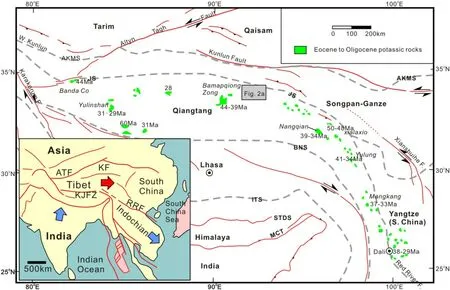
Fig. 1 Simplified geological map of the Tibetan plateau and surrounding areas (modified from Chung et al. 2005). Ages of post-collisional potassic magmas are shown in numerals(Zhang and Xie 1997;Chung et al.1998;Deng 1998;Ding et al.1999,2003;Wang et al.2001;Chung et al.2005;Hou et al.2006).Inset shows the Cenozoic tectonic extrusion in East Asia related to the India–Asia collision(after Tapponnier et al.1982).MCT = Main central Thrust;STDS = South Tibet delamination System;ITS = Indus–Tsangpo Suture;BNS = Bangong–Nujiang Suture;JS = Jinsha Suture; AKMS = Ayimaqin–Kunlun–Muztagh Suture; ATF = Tltyn Tagh Fault; KF = Kunlun Fault; KJFZ = Karakorum–Jiali Fault Zone; RRF = Red River Fault
Therefore, the volcanic rocks in this stage may have been generated by asthenosphere upwelling that was triggered by lithospheric delamination after plate collision in the Himalayan orogenic belt (Wu et al. 2008).
The Qiangtang alkaline/alkali-rich rocks are connected eastward with the Jinshajiang-Honghe alkali-rich intrusive rock belt (Hou et al. 2006). From the northern Nangqian thrust belt through the Batang-Lijiang and Gongjue-Mangkang fault zones, they extend southward into the Honghe fault zone, forming a huge alkali-rich intrusive rock belt with a scale of 1000 km (Fig. 1) that includes Nangqian(~96°E, 39–34 Ma), Xialaxio (~96.8°E, 50–48 Ma),Yulong (~97.6°E, 41–34 Ma), Mangkang (~99°E,37–33 Ma), and Dali (~99.5°E, 38–29 Ma) (Fig. 1). The formation dates of these rocks are concentrated between 41 and 27 Ma(Zhang and Xie 1997;Chung et al.1998;Wang et al. 2001; Hou et al. 2006). These alkali-rich intrusive rocks mainly come from the crust-mantle transition zone between the bottom of the lower crust and the top of the lithospheric mantle (Hou et al. 2003a; Wang 2003). The potential genesis for the generation of these alkali-rich rocks may be caused by the decompression melting,which was in turn induced by large-scale strike-slip fault system(Hou et al. 2003a) or caused by the upwelling of deep asthenospheric materials related to intracontinental subduction and plate break-off (Zhong et al. 2001;Jiang et al.2006).
Hou et al.(2006)suggested that the CQP and EQP are in a unified deep dynamic process during the Eocene Oligocene,but the formation of these alkali rocks has proceeded through two different genetic mechanisms(Hou et al.2006;Wu et al. 2008). The locations and characteristics of these two different genetic mechanisms are still unclear. In this study, we report the results of petrological analysis, zircon U–Pb dating, Hf isotope analysis, and whole rock geochemical analysis of trachyte and orthophyre in the Tuotuohe region. These data are used to constrain the rockformation age, origin, and tectonic background, and to develop a genetic model for the formation of volcanic rocks in the Tuotuohe region. Our study provides new evidence about the timing of the transition between the two mechanisms for alkaline/alkali-rich rocks in the late collisional stage of the CQP and EQP.
2 Geological background and sample descriptions
The Tuotuohe region is located at the northern margin of the Qiangtang Block, belonging to the CQP (Fig. 1). The Qiangtang Block is a main part of the Tethys tectonic domain and lies at the intersection of the Bayan Har and Lhasa terranes,both of which have experienced a complex tectonic evolution since the Paleozoic. This tectonic evolution occurred in two main stages: the subduction of the Tethys Ocean and the collision between the Indian and Asian continents. The subduction of the Paleo-Tethys Ocean, which developed on the northern margin of the Qiangtang Block, started in the Permian and ended in the Late Triassic(Qian et al.2014).The subsequent subduction of the Bangongho–Nujiang Ocean lasted from Late Jurassic to Late of Early Cretaceous. The final collision of the Paleo-Tethys Ocean and the Bangonghu-Nujiang Ocean resulted in the collage of the Bayan Har, Lhasa, and Qiangtang Blocks (Fan 2015). Next, the initial collision period between the Indian and Eurasian plates occurred at 65 Ma, following by continued crust thickening at the Qinghai-Tibetan Plateau (Mo et al. 2007).
The strata exposed in the Tuotuohe region are mainly composed of sedimentary and volcanic rocks since Carboniferous (Liu et al. 2011a, b; Li et al. 2012). Early Triassic strata are absent in the region,and a Triassic–Permian unconformity reflects orogenesis during the evolution of the ancient Tethys Ocean (Zhao et al. 2004; Liu et al.2011a, b). A second regional unconformity between Paleogene and Cretaceous strata indicates that the study area was influenced by Himalayan orogenesis.
The geology of the region is dominated by the active continental margin, and intracontinental tectonism has resulted in extensive deformation.The main faults,most of which are thrust faults, trend WNW–ESE and approximately E–W (Fig. 2a).
Intense magmatism began in the late Carboniferous and ended in the Eocene. The intrusive rocks are exposed on both sides of the Tuotuohe River. The extrusive rocks are exposed in all sections throughout the study areas, most of which were formed in the Late Triassic.
In this study, trachyte samples (NRNY-12) and orthophyre samples (NRNY-11, ZMQ) are from the Nariniya area (Fig. 2b), and Zamuqu area (Fig. 2c). In the Nariniya area, volcanic rocks are widely distributed, contain mafic minerals, and show little distinction in lithology which ranges from trachyte, to basalt, to basalt andesite, but trachyte is the main lithology. The trachyte erupted directly onto the conglomerate of the Jurassic Xiali Formation,covered by Quaternary sedimentary in the east, and intruded by grey-white orthophyre in the south. The NWtrending faults, which are parallel to main structural direction in the region,cut the trachyte in the middle of the study area (Fig. 2b). The lower Cretaceous strata are the oldest rocks exposed in the Zhamuqu area, especially the Cuoriju Formation (K1c), which consists of brick red quartz sandstone, gray conglomerate and magenta mudstone. The grey-flesh red orthophyre and the grey diorite porphyry are located in the east, with an outcrop area of 10 km2(Fig. 2c).
The trachyte (NRNY-12) shows porphyritic texture,massive structure(Fig. 3a,b).It consists of phenocryst and groundmass. The mineral composition of phenocryst is sanidine (40–50%), plagioclase (25–35%), aegirine-augite(10–15%), and biotite (3–5%). The sanidine in phenocryst is platy in structure with cross striation on the surface and particle sizes around 0.4–2 mm. The aegirine augite is slab-column in structure and octagon in shape,and it shows green–light green zone with particle sizes around 0.5–1 mm.
The sample NRNY-11 and ZMQ orthophyre display porphyritic texture (Fig. 3c–f). The phenocryst (25–35%)is made up of amphibole (7–10%), biotite (3–5%) and potassium feldspar (15–20%) with an euhedral–subhedral shape. Feldspar is colorless, square slab in shape, and Carlsbad twin can be seen. Amphibole showed a slabcolumn structure with a set of perfect cleavage on the longitudinal section,oblique extinction.Biotite is schistose with a set of perfect cleavage, parallel extinction. The particle diameter of phenocryst is about 0.5–1 mm,and the groundmass (60–65%) has the same mineral composition as the phenocryst, with a cryptocrystalline–microcrystalline texture.
3 Analytical methods
3.1 Zircon U-Pb dating
Zircon grains were extracted using a combination of heavy liquid and magnetic separation techniques at the Langfang Regional Geological Survey, Hebei Province, China. The zircons were then handpicked under a binocular microscope before being mounted in epoxy resin and polished to expose the center of individual zircons. Cathodoluminescence (CL) imaging was used to determine the internal structures of the zircons and to choose the target areas for LA–ICP–MS analysis. LA–ICP–MS analysis was undertaken at the Institute of Mineral Resources, Chinese Academy of Geological Sciences, Beijing, China. A spot diameter of 32 μm was used for each analysis, and the analytical procedures followed those of Hou et al. (2007).U/Pb ratios were corrected using analyses of the standard zircons GJ-1 and M127 (U = 923 ppm, Th = 439 ppm,and Th/U = 0.475; Nasdala et al. 2008). The 2σ errors in standard calibration for207Pb/206Pb,206Pb/238U, and207Pb/235U were all approximately 2%,and 1%for analyses of the zircon standard.Data was reduced using the ICP–MS DataCal software of Liu et al. (2008). Common Pb was corrected using the ComPbCorr#3.1 correction procedure for zircons with common206Pb concentrations of >1%(Anderson 2002), and U–Pb ages were calculated using Isoplot 3 software (Ludwig 2003).

Fig. 2 Geological sketch maps of research areas.a Geological sketch maps of Tuotuohe region(after Qian et al.2014);b Geological sketch map of Nariniya (NRNY); c Geological sketch map of Zhamuqu (ZMQ)
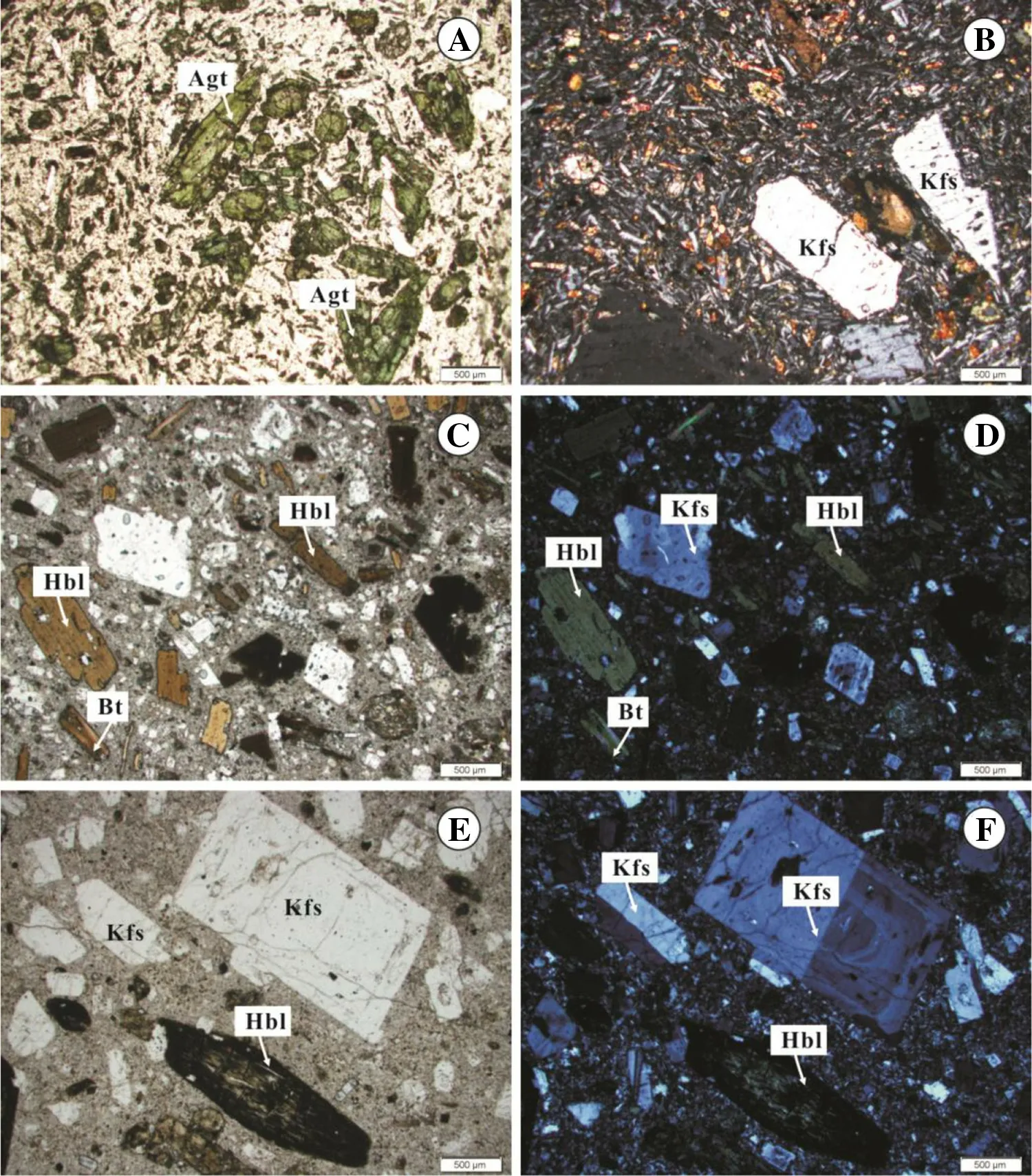
Fig. 3 Microphotomicrographs of the Cenozoic alkaline in the Tuotuohe region. a, b Trachyte sample from NRNY-12; c,d orthophyre sample from NRNY-11; e, f orthophyre sample from ZMQ. a, c and e Plane-polarized light;b,d and f cross-polarized ligh. Agt—augite; Kfs—potash feldspar;Hbl—hornblende; Bt—biotite;Qcy—quartz pyroclast; Fcy—feldspar crystal pyroclast
3.2 Major elements and trace elements
Whole-rock major and trace elements analysis were performed at ALS Minerals-ALS Chemex,Guangzhou,China.The concentrations of major elements were measured with Axios X-ray fluorescence (XRF) (PANalytical, Holland).Analytical uncertainties of the measurements were lower than 2%and the measurements were accurate to within 2%of the reference materials. The analysis of trace and rare earth elements followed the method of seal HF + HNO3digest samples and then turned into 1% HNO3matrix.Trace element concentrations were measured by ICP-MS using PEElan6000, with Rh as an internal standard to monitor signal drift during analysis. Analytical procedures are similar to those in Qi et al.(2000).The error of REE is lower than 7%and the others of trace elements are less than 10%.
3.3 Hf Isotopes
The analysis of in situ zircon Lu–Hf isotopes was based on LA-ICP-MS zircon dating and referred to the cathodoluminescence (CL) images at the place of original age determination or around. This analysis was conducted at the Key Laboratory of Metallogeny and Mineral Resource Assessment Institute of Mineral Resources, Chinese Academy of Geological Sciences, using Neptune multicollector plasma mass spectrometry together with a Newwave UP213 laser-ablation system. The denudation diameter is 40 μm in our study and Helium was applied as a carrier gas. Zircon GJ-1 was employed as the reference standard during the process of age determination (Elhlou et al. 2006). The test procedures and management details followed those described by Hou et al. (2007). The calculations of εHf(t), TDM1, and TDM2have adopted a model with (176Lu/177Hf) chondrite = 0.03321, (176Hf/177Hf)chondrite = 0.282772 (Bizzarro et al. 2002); (176Lu/177Hf)depleted-mantle = 0.03842, (176Hf/177Hf) depleted-mantle = 0.28325 (Griffin et al. 2000); (176Lu/177Hf) average continental crust = 0.015(Veevers et al.2005);λ(176Lu) =1.867 × 10-11a-1(So¨derlund et al. 2004).
4 Analytical results
4.1 Zircon U-Pb dating
Dating results of the LA-ICP-MS analyses for 3 samples are summarized in Table 1.
Zircons from trachyte and orthophyre samples (NRNY-12, NRNY-11, ZMQ) are dominantly euhedral or subhedral, most in a long columnar crystal, and display oscillatory zoning(Fig. 4a–c).The analyzed zircon grains have U concentrations of 46.8–1710 ppm, Th concentrations of 56–1899 ppm, and Th/U ratios of 0.8–2.5, indicative of their magmatic origin.
The results of nineteen analyses of trachyte zircons(NRNY-12) plot on, or close to, the U–Pb Concordia line,yielding a weighted-mean206Pb/238U age of 39.6 ± 0.2 Ma (MSWD = 0.34; Fig. 4d), which is interpreted as the crystallization age of the trachyte.
Seventeen analyzed spots on the orthophyre zircons have206Pb/238U ages ranging from 37.2 to 37.9 Ma(Table 1), with a weighted mean206Pb/238U age of 37.6 ± 0.1 Ma (MSWD = 0.61, n = 17, Fig. 4e), which is interpreted as the formation age of the orthophyre.
Nineteen data points analyses plot on,or close to,the U–Pb Concordia, and the weighted-mean206Pb/238U age is 32.0 ± 0.1 Ma (MSWD = 1.4, n = 19; Fig. 4f), which is interpreted to present the crystallization age of the trachyte.
4.2 Major and trace elements
4.2.1 Major elements
Analytical results of major and trace elements for three rock samples are summarized in Table 2.
NRNY-12 samples have high SiO2contents(53.43–58.41%) and total alkali contents (9.72–10.72%)with the existence of alkaline dark minerals. The samples are high in MgO (3.04–3.94 wt%) and Mg# (0.58–0.64),but low in Al2O3(12.73–13.94 wt%).Geochemically,they belong to the alkaline series (Fig. 5a), with A/CNK ratios varying from 0.47 to 0.59, showing metaluminous characteristics (Fig. 5b). NRNY-11 and ZMQ samples have high SiO2contents (63.78–66.95%) and total alkali contents (9.99%–10.60%). They have K2O/Na2O ratios of 1.35–1.41, and A/CNK ratios of 0.87–0.90. In the TAS diagram, all samples plot in the alkaline series field(Fig. 5a), and are classified as metaluminous in the A/NK versus A/CNK diagram (Fig. 5b). Samples have low contents of MgO (0.81%–1%) and TiO2(0.51–0.56%), with Mg# ranging from 0.33 to 0.36. Orthophyre samples show characteristics of high silicon, high potassium and low magnesium content.
4.2.2 Trace elements
Nariniya trachytes have high rare earth element (REE)contents ranging from 493 ppm to 548 ppm, LREE/HREE ratios between 16 and 18, and (La/Yb)Nvalues of 34–44(Table 2), which indicate significant fractionation between light and heavy REE (Fig. 6a). Samples display weak negative Eu anomalies (δEu = 0.9–0.95) suggesting that plagioclase may have played a minor role in the process of fractional crystallization. This is in stark contrast to island arc volcanic, which display strong negative Eu anomalies.In the primitive mantle-normalized trace elements spider diagram (Fig. 6b), all samples are enriched in large ion lithophile elements (LILE) such as Rb, Ba, Th and U, and depleted in high-field strength elements (HFSE) such as Nb,Ta and Ti.All samples have strong compatible element contents (e.g., Cr, Ni) higher than island arc volcanics as well.
Orthophyres(NRNY-11 and ZMQ)are characterized by enrichment in LREE and depletion in HREE, showing the uniform allocation mode of REE from trachyte (NRNY-12). Total REE contents range from 383 ppm to 517 ppm with (La/Yb)Nratios of 45–68. Samples display weak Eu anomalies (δEu = 0.85–1.05) suggesting that plagioclase played a minor role in the process of fractional crystallization.The samples are rich in LILE such as Rb,Ba,Th,U and K, and depleted in HFSE such as Nb, Ta and Ti.
4.3 Zircon Lu-Hf isotopes
Based on the zircon U–Pb dating from LA-ICP-MS, the three types of rocks in the study area were analyzed for Lu–Hf isotope of zircon.The results of this analysis are shown in Table 3.176Hf/177Hf ratios range from 0.282660 to 0.282843, εHf(t) values range from - 3.2 to + 3.8, and two-stage model ages (TDM2) range from 865 to 1195 Ma.In εHf(t)-Age diagram, these three samples plot around Chondrite-curve (Fig. 7). The Hf isotopic values of these three samples are consistent within errors, indicating that they are cognate in origin.
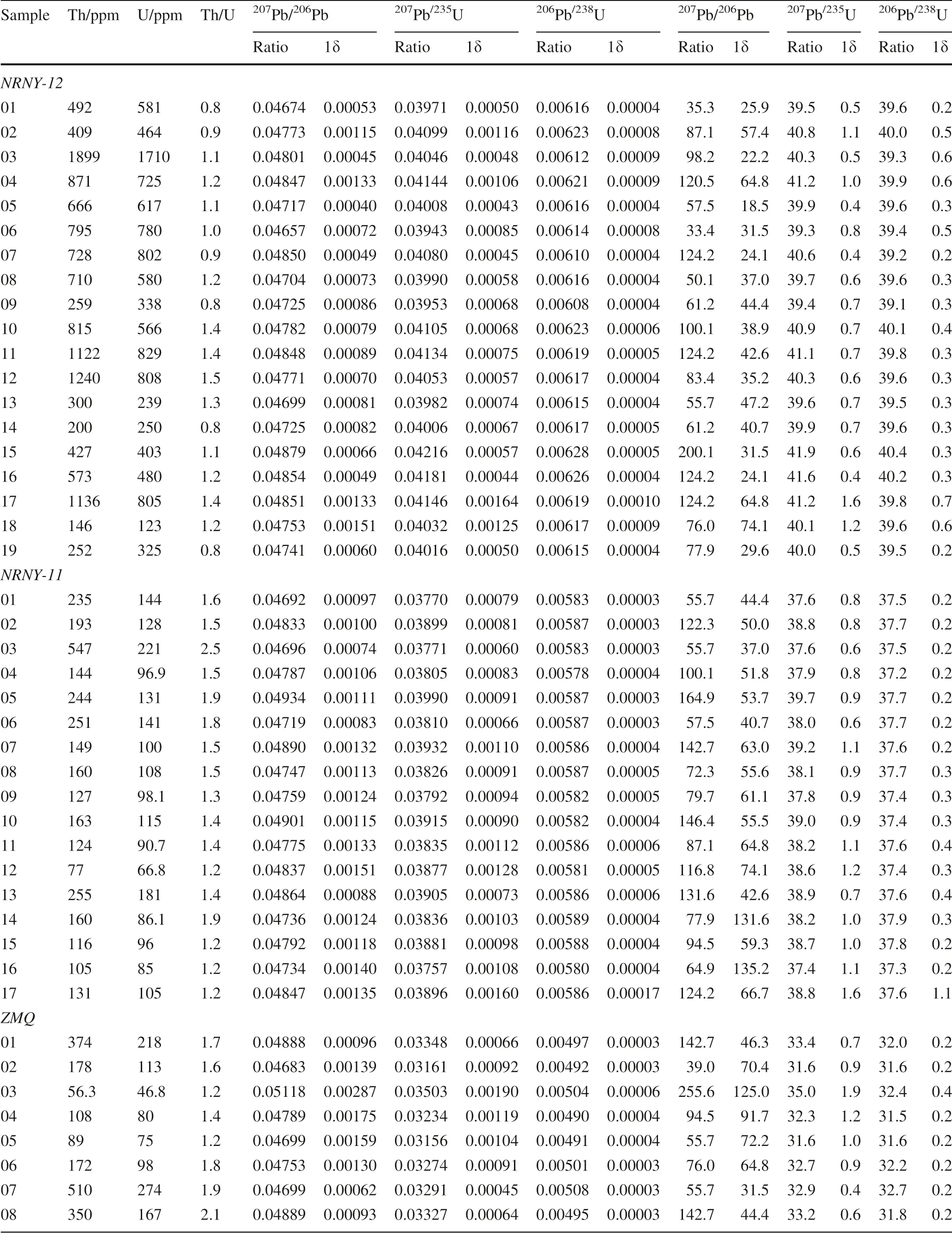
Table 1 LA–ICP–MS zircon U–Pb dating data for the Cenozoic igneous rocks in the Tuotuohe region
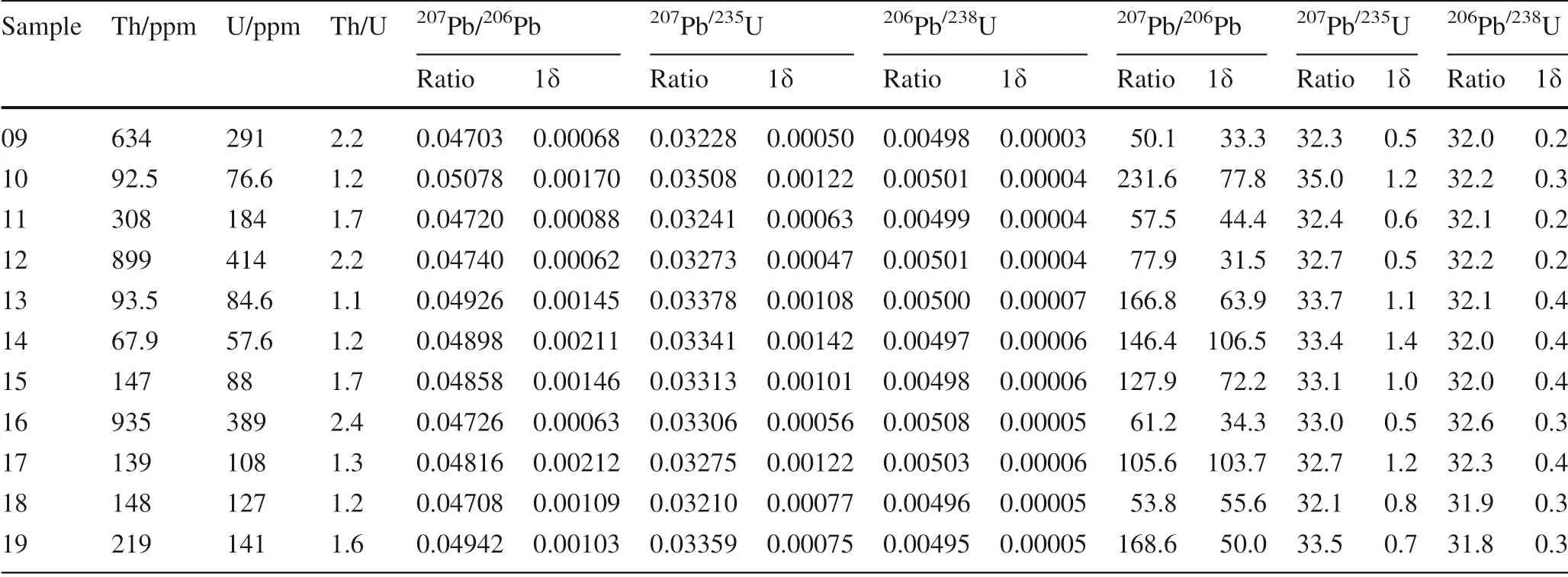
Table 1 continued
5 Discussion
5.1 Ages of magmatic rocks
The features of zircons from trachyte sample NRNY-12 indicate that the sample has a magmatic origin, and its U–Pb age indicates its formation age is 39.6 ± 0.2 Ma. On the basis of stratigraphic correlation, the trachyte belongs to the Chabaoma Formation (Ec), which is widespread to the west of the Tuotuohe River and along the Ulan Ul montain–Jurhen mountain belt. The volcanic rocks are older than those exposed in the Hoh Xil belt(12.2–16.6 Ma, Wei et al. 2007) and the middle Kunlun belt to the north. Sample NRNY-11 displays an age of 37.6 ± 0.1 Ma,similar to that of trachyte.Therefore,these samples may represent separate events in a common magmatic system. The ZMQ orthophyre intrudes the Sangkashan Formation of the Upper Cretaceous Fenghuoshan Group. Zircon U–Pb dating of the orthophyre yields an age of 32.0 ± 0.1 Ma.
Our new chronological data further support the intense magmatic activity at 39.6–32 Ma in the Tuotuohe region.Furthermore, the Eocene–Oligocene magmatism is not restricted in the Tuotuohe region, but is widespread in other parts of the Qiangtang Block(Fig. 1).Recent studies have examined magmatism in the Qiangtang Block (Deng 1998; Ding et al. 1999, 2003).
Multiple lines of evidence for large-scale Eocene–Oligocene magmatic events have been documented,including a U–Pb SHRIMP zircon age of 44.3 ± 1.8 Ma for the Lake Dongyue volcanic rocks (Dong et al. 2008); a single-grain zircon U–Pb age of 40 ± 3 Ma for monzogranite from the Middle Qiangtang Block (Bai et al. 2006); an age of 40.6 ± 3.1 Ma for the Saiduopugangri Granite(Duan et al.2005);40Ar/39Ar ages of 42–39 Ma for high-K calc-alkaline volcanic rocks from the Jurhen Ul mountains; zircon U–Pb ages of 34.64 and 35.03 Ma for the Zougouyouchacuo and Nadingcuo volcanic rocks from the Qiangtang Block (Liu et al. 2009); and an40Ar/39Ar age of 30 Ma for Cenozoic potassic volcanic rocks in the northern Gemucuo area (Zhai et al. 2009). These studies demonstrate that large-scale magmatic events occurred in the Qiangtang Block from the Eocene to the Oligocene.
5.2 Genesis of the alkaline rocks and nature of the source
The studied rocks(NRNY-12,NRNY-11,ZMQ)belong to alkaline rocks (Fig. 5a). There are four sensible mechanisms that have been proposed for the formation of the alkaline rocks: (1) generation by partial melting of the upper mantle, followed by ascension along the deep fracture and emplacement at the shallow place with crustal contamination (Tu 1989); (2) direct derivation from the asthenosphere and brought material up from continental crust, or the oceanic crust, to relatively shallow place (Xu and Wang 2003); (3) partial melting of crust associated with the underplating of mafic magma, in addition, trachytic magmas can be produced by anatexis of the lower crust (Wyllie 1977);and(4) mingling of a basaltic magma with a granitic melt (Mingram et al. 2000).
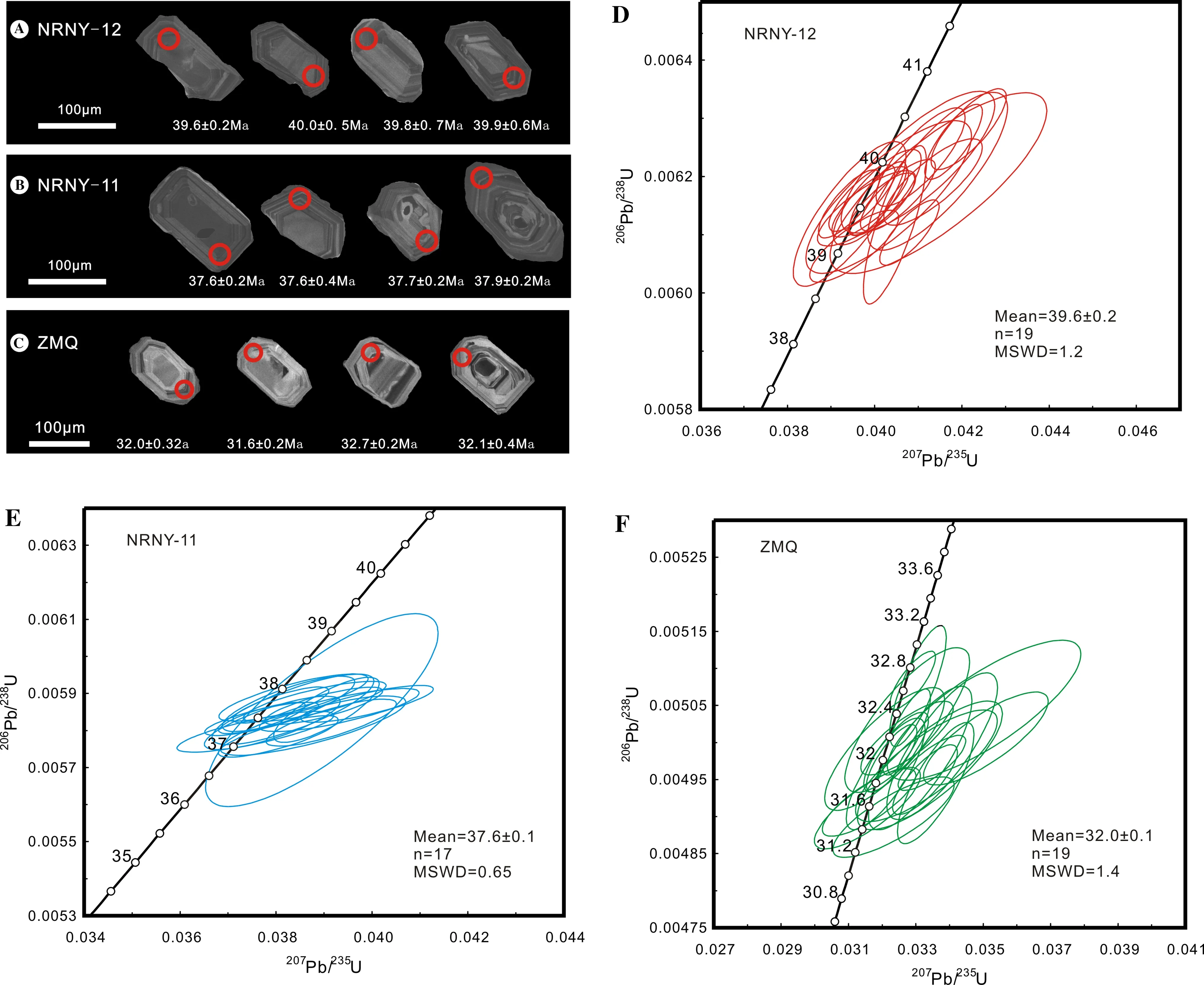
Fig. 4 Zircon CL images and U-Pb Concordia diagrams of the Cenozoic igneous rocks in the Tuotuohe region
The strong depletion of HREE and high Sr/Y and (La/Yb)Nvalues, together with the negligible Eu anomalies(Fig. 6a).Thus,the garnet may have remained as a residual phase, while plagioclase was lacked in the source (Petford and Atherton 1996;Rapp and Watson 1995),which further suggests that partial melting of the magma source occurred under high-pressure conditions. This high-pressure environment may have resulted from either the deep subduction of oceanic crust, thickening of the lower crust, or asthenosphere upwelling. Moreover, samples have relatively high SiO2concentrations (53.43–66.95 wt%), are enriched in LREE and LILE, and are depleted in HFSE(Nb, Ta, and Ti), characteristics which are typically associated with subduction-related arc magmatism at convergent plate boundaries.However, many studies have shown that magma formed in a post-collision setting may show a geochemical affinity to subduction-related arc igneous rocks(Aldanmaz et al.2000).The Xijir Ulan-Yushu Ocean has closed in the Late Triassic,and recent geophysical data indicate that the Indian Plate did not subduct below the Qiangtang Block in the Cenozoic (Xiao et al. 2001).Therefore, the Oligocene magmatic activity had no temporal or spatial relationship with subduction. In contrast,the Paleo-ocean had already closed after Late Triassic,and the continental crust continued to thicken, which may be the sensible explanation. Therefore, the formation of the alkaline rocks might be closely related to a post-collision environment in the Qinghai–Tibet Plateau (Hou 2010).
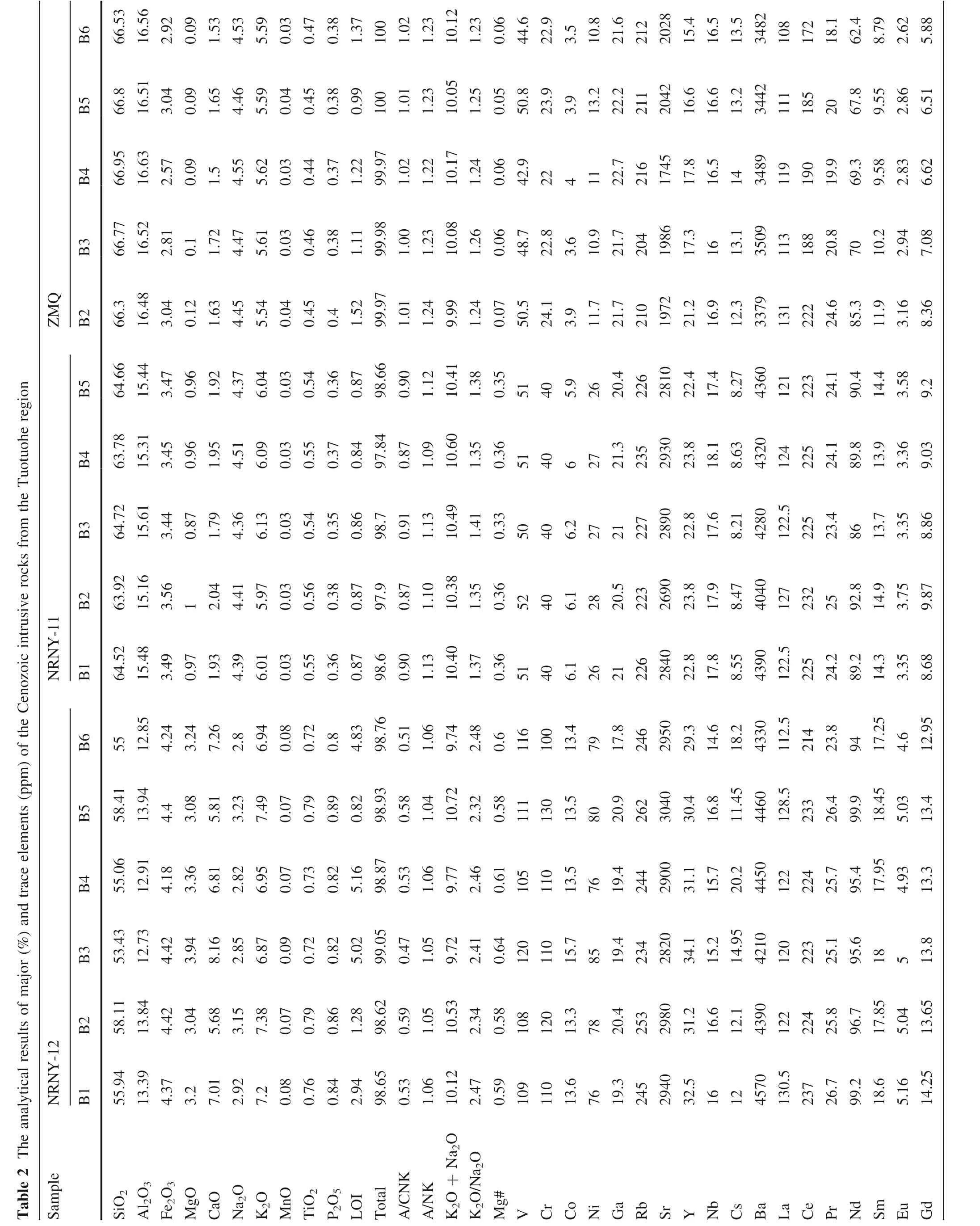
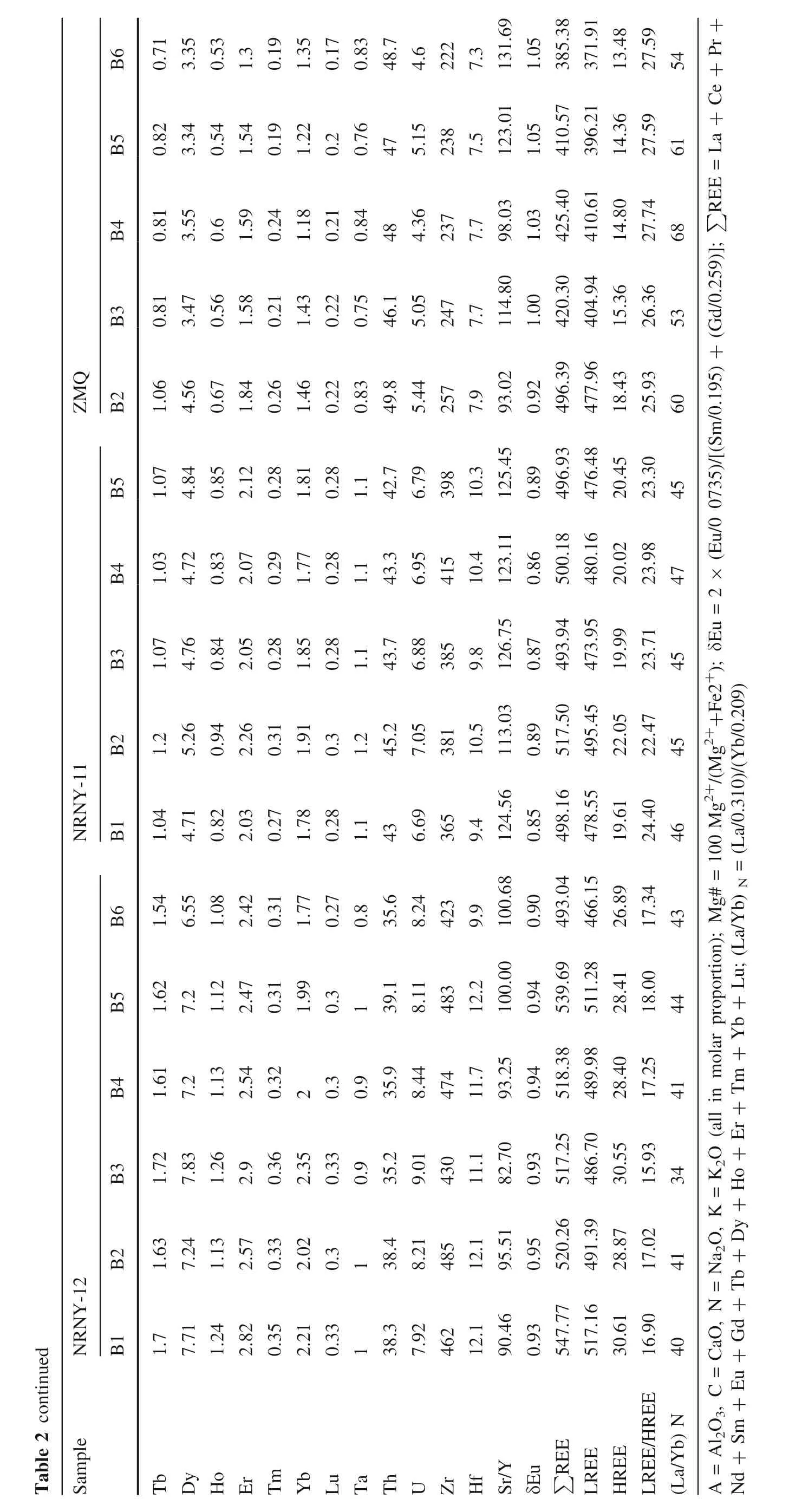
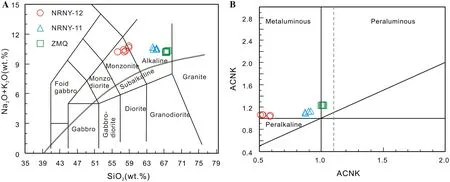
Fig. 5 Petrochemical diagrams for the Cenozoic intrusive rocks from the Tuotuohe region. a Plots of total alkali versus SiO2 (TAS) diagram.The boundary line between alkaline and the subalkaline series is from Irvine and Baragar (1971). b A/CNK [Al2O3/(CaO + Na2O + K2O)]versus A/NK [Al2O3/(Na2O + K2O)] diagram. (After Peccerillo and Taylor 1976)
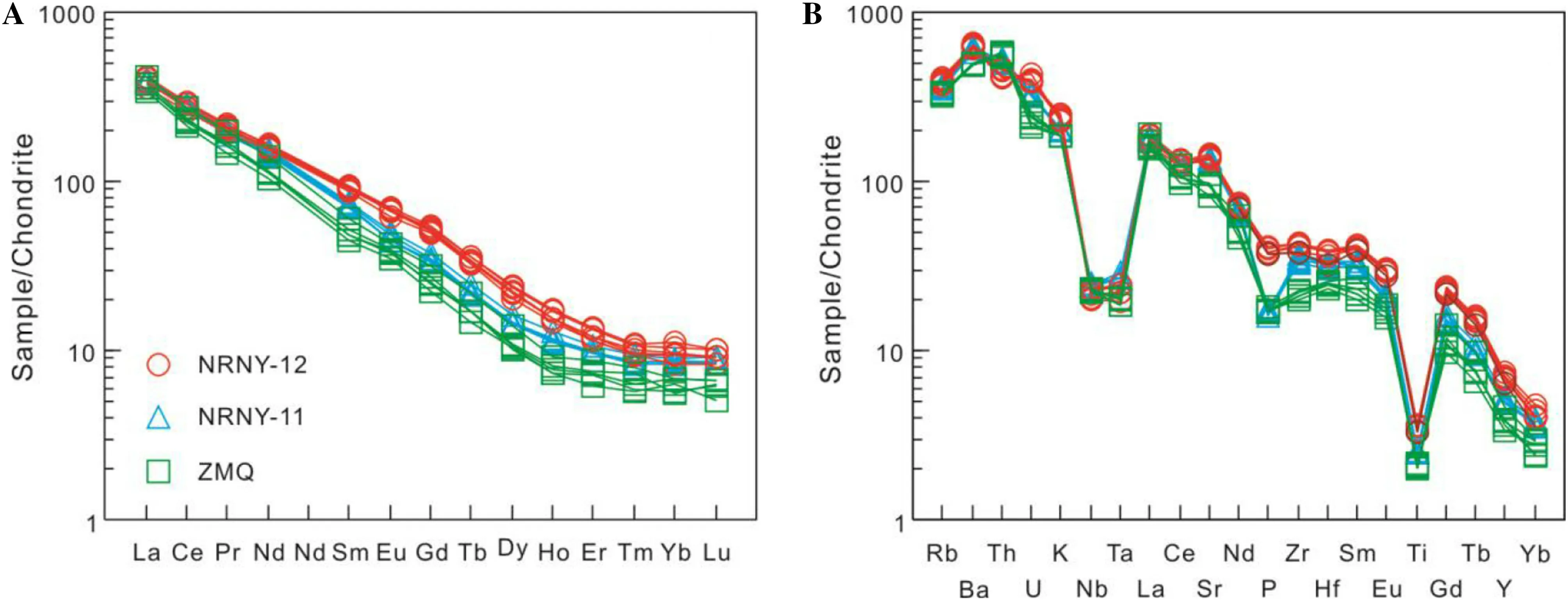
Fig. 6 Chondrite-normalized REE patterns [a normalization values after Boynton (1984)] and primitive chondrite-normalized trace element spider [b normalization values after Sun and McDonough (1989)] diagrams for the Cenozoic intrusive rocks in the Tuotuohe region
The Nb/U and La/Ce values of the magma would not have been influenced by partial melting or crystal fractionation (Hofmann et al. 1986), but Rb/Sr is sensitive to crustal–mantle interaction. Therefore, La/Ce and Rb/Sr values provide an accurate means by which to evaluate the properties of the magma source.In the Rb/Sr versus La/Ce and Rb/Sr versus Nb/U diagrams, all the samples plot on,or close to, the lower crustal source evolution lines, confirming the origin of the crustal source (Fig. 8a, b). Notably, the three rocks used in this study also show a distinguished feature which is inconsistent with the origin of crustal source. Thus, the most sensible explanation is given below.(1)The trachyte samples(NRNY-12;40 Ma)contain high amounts of MgO and Mg# (0.59–0.64).Experimental petrological data indicate that the rocks were generated by partial melting of basaltic lower crust with an Mg# value of <0.45 (Rapp et al. 1999). These characteristics indicated that the rocks may derive from mantle materials rather than a simple crustal origin. Furthermore,their Nb/Ta and Zr/Hf ratios are relatively constant, ranging from 16 to 18.25 (with an average value of 17), and from 38.18 to 42.72 (with an average value of 39.97),respectively. Compared with the corresponding ratios of the crust(11.4 and 33,respectively)(Taylor and McLennan 1985), their ratios are closer to the primitive mantle (17.8 and 37, respectively) (McDonough and Sun 1995). This geochemical evidence further confirmed that the magma source derived from the mantle derived material is one possible scenario.However,the trachyte contains relatively high amounts of Cr (100–130 ppm), Co (13.3–15.7 ppm),and Ni (76–85 ppm), higher than the continental crust but lower than the mantle.These features may indicate an input of crustal materials. The isotopic data exhibit variable εHf(t)values(ranging from- 2.05 to 2.92)(Fig. 7),with a TDM1age of 568–789 Ma,and TDM2age of 875–1162 Ma.The samples show mostly positive εHf(t) values and few negative εHf(t) values (Fig. 7). Consequently, we can confirm that the magma source may derive mainly from depleted mantle with input of crustal material. The formation process of these rocks may have been that the thickened mafic lower curst was removed into the asthenosphere and the mixing magma ascended to the shallow place where the rocks formed. (2) The coeval orthpphyre sample (NRNY-11; 38 Ma) contain relatively low amounts of MgO and Mg# (0.33–0.36), and low amounts of Cr (40 ppm), Co (5.9–6.2 ppm), and Ni(26–28 ppm), with Nb/Ta and Zr/Hf ratios of 14.9–16.5(with an average value of 15.9) and 36.3–39.9 (with an average value of 38.6), respectively. These features are consistent with those of magma that is derived from the melting of crust with input of mantle materials. The isotopic data show extremely narrow εHf(t) values (ranging from - 2.6 to 1.1, with most negative εHf(t) values and only a few positive values) (Fig. 7), together with a TDM1age of 686–815 Ma, and a TDM2age of 865–1035 Ma,further confirming the limited role of the mantle materials.Therefore, the orthpphyre sample (NRNY-11) may have formed from partial melting of the crust with input of mantle materials. (3) The orthophyre samples (ZMQ;32 Ma) contain low amounts of MgO and Mg#(0.05–0.07), and low amounts of Cr (22–24.1 ppm), Co(3.5–3.96 ppm), and Ni (10.8–13.2 ppm), indicating a crustal source. However, the sample’s Nb/Ta and Zr/Hf ratios are relatively constant, ranging from 19.71 to 21.87(with an average value of 20.61), and from 30.62 to 32.41(with an average value of 31.5), respectively. This characteristic may be affected by mantle materials.The isotopic data exhibit εHf(t)values ranging from- 3.2 to 0.2,with a TDM1age of 689–825 Ma and a TDM2age of 890–1062 Ma. Most of the εHf(t) values are negative(there are only three positive values). Based on the geochemical and isotopic data, we suggest the orthophyre sample was derived from partial melting of a crustal source with different possible degrees of addition of mantle materials.
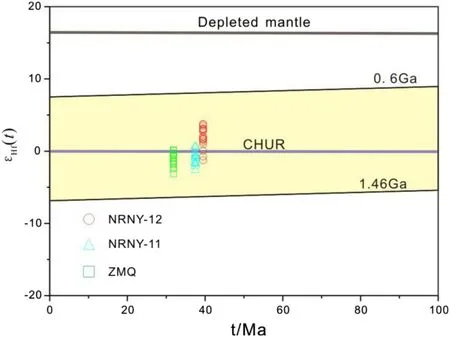
Fig. 7 Zircon Hf isotopic features for the Cenozoic intrusive rocks in the Tuotuohe region
We propose that the following process generated the alkaline compositions of the studied rocks. First, the crust continued to thicken, and the resulting gravitational instability caused delamination. The sinking crust underwent partial melting due to the upwelling of high-temperature asthenosphere and formed a low-density, buoyant melt.This melt migrated through the asthenospheric mantle and interacted with the surrounding material during its ascent from the lower crust to the surface. This process recycled lithosphere crust into the mantle. The melt was contaminated by the mantle as it migrated, and the high concentrations of compatible elements in NRNY-12 suggest a mantle contribution. In summary, we propose that the trachyte NRNY-12 was generated by the delamination of thickened lower crust and partial melting in the asthenosphere.
The differing compositions of the orthophyres (NRNY-11 and ZMQ) can be explained by the following process.Thickening of the lower crust resulted in the delamination and upwelling of asthenospheric mantle, in turn causing partial melting of the basaltic lower crust and generating an alkaline magma that ascended to the surface along structural conduits, where it formed alkali rocks. This process explains why these rocks do not contain high concentrations of magnesium or compatible elements.
The Qiangtang Block has two distinct geological features:laterally extensive Paleogene shoshonitic rocks and a predominance of shonshonitic basic compositions. These features cannot simply be explained by a minimal degree of melting. The present samples are enriched in large ion lithophilic elements,and the La/Ce–Rb/Sr and Nb/U–Rb/Sr diagrams suggest that they evolved through crustal assimilation (Fig. 8).
The chondrite normalized REE diagrams and primitive mantle normalized trace element diagrams (Fig. 6a, b) for the trachyte and orthophyre rocks from Nariniya show similar patterns and differ only with respect to a few specific elements (e.g., P), indicating that they share a common magma source. These geochemical features are similar to the Cenozoic ultra-potassic rocks of the Lhasa terrane (Zhao et al. 2006). Based on the chronological distinction of the three rocks, together with the above discussion, we confirm that the formation of the trachyte(NRNY-12) and orthophyre (NRNY-11) undergone multiple evolution of parental magma in the similar tectonic setting and the Zhamaqu rocks also formed in lithosphere delamination setting. The deep-seated evolution of this tectonic and magmatic activity may have been closely related to delamination and partial melting of the lower crust, as well as mantle upwelling. Potassic volcanic rocks and trachyte with similar crust-mantle mixing origin have also been found in the Lhasa terrane (Zhao et al. 2006;Chen et al. 2010; Liu et al. 2011a, b).

Table 3 continued
5.3 Tectonic setting and regional tectonic evolution
Cenozoic tectonics in the Tuotuohe region was controlled mainly by India–Asia collision and uplift of the Qinghai–Tibet Plateau. The northward subduction of the Indian Plate during the Cenozoic led to intense N–S crustal shortening and thickening of the crust beneath the plateau(Powell and Conaghan 1995; Barazangi and Ni 1982).However, geophysical data show that the Indian Plate has not yet subducted beneath the Qiangtang Block (McNamara et al.1994;Owens and Zandt 1997;Xiao et al.2001),meaning that subduction has had limited influence on crustal thickening in the northern part of the plateau(Clark Burchfiel and Royden 1991). Instead, the majority of studies(Zhang et al.2002;Duan et al.2005;Li et al.2006;Hou 2010; Wu et al. 2011) have argued that crustal shortening in the interior of the plateau caused a concomitant crustal thickening in the northern part of the plateau and resulted in the formation of a related largescale thrust nappe structure. This structure is the most prominent tectonic feature in the Tuotuohe region.
The nappe belt propagated to the northwest (Spurlin et al. 2005; Li et al. 2006) and caused 61 km of crustal shortening, resulting in twice the normal thickness of the continental crust (Spurlin et al. 2005; Xu et al. 2006).Intense intra-continental deformation and associated magmatic activity is apparent across the region, with the main magmatic phase spanning the period from 50 to 32 Ma(Wu et al. 2008).
Over-thickening of the crust causes high-pressure conditions of the amphibolite to change granulite facies and then to the eclogite facies. The density of rocks of these facies exceeds that of asthenosphere, and gravitational instability leads to delamination of the lower crust and lithospheric mantle (Gao and Jin 1997). Upwelling of the asthenosphere heats the surrounding crustal rocks, causing partial melting and the formation of silica-rich low-density magma, which migrates upwards. In addition, the mafic lower crust descends into the asthenosphere, due to the increase in temperature, which results in partial melting of the mafic lower crust in the asthenosphere and forming the mix magma, which generates a melt that ascend to the surface and formed the trachyte. The upwelling asthenosphere directly heated the lower crust and formed the parental magma that generated the orthophyre (Fig. 9).
A large amount of 44–29 Ma magmatic activity that shares the same origin under the lithosphere delamination setting, was also discovered in the west side of Tuotuohe by predecessors (Deng 1998; Ding et al. 1999, 2003;Chung et al. 2005). It is reasonable to conclude that delamination in the Qiangtang Block extends from Bangda Co(82°E)near the Altun Fault to Tuotuohe(92°E)through Bamaqiongzong (90°E) in the Eocene–Oligocene.
The NNW-trending alkaline rock belts of 1000 km long formed in the EQP(41–27 Ma,Hou et al.2006)are related to large-scale strike-slip fault systems (Hou et al. 2003b)and intracontinental subduction and plate break-off(Zhong et al.2001;Jiang et al.2006).This NNW-trending alkaline rock zone intersects the northern boundary of Qiangtang Block at 93°E (Fig. 1). Based on the above discussion, we speculate that the boundary of the two diagenetic mechanisms (delamination-induced melting and tectonic systeminduced melting) may be between 92°E and 93°E, and the generated alkaline rocks in Tuotuohe region (92°E) may represent the easternmost segment of the Qiangtang Block triggered by the Eocene–Oligocene delamination.
6 Conclusion
Based on the analysis of Paleogene magmatic petrography,zircon U–Pb ages,Hf isotope data,and geochemical data of rocks from the Tuotuohe region, and combined with the regional tectonic evolution history, we draw the following conclusions:
1. The activity time of the alkaline magma in the Tuotuohe region ranges from 39.6 to 32.0 Ma, indicative of Eocene–Oligocene magmatism.
2. Two mechanisms are possible for the origin of the alkaline rocks in the Tuotuohe region:(1)the removed mafic lower crust dropped into the asthenosphere,forming the mix magma which formed alkaline rocks like the Nariniya trachyte; (2) the upwelling asthenosphere triggered the crust melting that formed alkaline rocks like the orthophyre in the Nariniya and Zamaqu area.
3. The Tuotuohe region may be the easternmost section of Qiangtang Block affected by Eocene–Oligocene delamination.
AcknowledgementsThe authors would like to thank two anonymous journal reviewers for critical reviews and helpful comments which greatly improved the manuscript.This indoor research was supported by Dr. Huo Liang, College of Earth Science, Jilin University. Field geological work was supported by colleagues in Qinghai Geological Survey and the Qinghai Fifth Geological and Mineral Exploration Institute. The authors would like to acknowledge the above-named individuals and institutes for their support and help.This research was funded by the National Natural Science Foundation of China (Grant No. 41402060).
杂志排行
Acta Geochimica的其它文章
- Chemical structure of the Earth’s mantle defined by fast diffusion elements like helium
- A helium stratified and ingassed lower mantle: resolving the helium paradoxes
- Mechanism of accelerated dissolution of mineral crystals by cavitation erosion
- Zircon chemistry and new laser ablation U-Pb ages for uraniferous granitoids in SW Cameroon
- Evaluation of the potential risks of heavy metal contamination in rice paddy soils around an abandoned Hg mine area in Southwest China
- Low-temperature alteration of uranium-thorium bearing minerals and its significance in neoformation of radioactive minerals in stream sediments of Wadi El-Reddah, North Eastern Desert, Egypt
